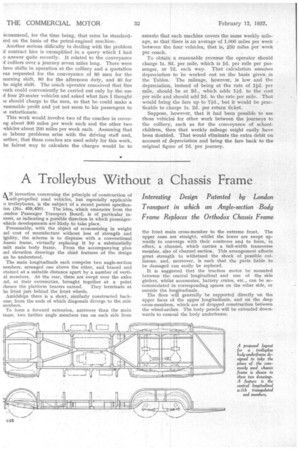Trolleybus Without a Chassis Frame
Page 98

If you've noticed an error in this article please click here to report it so we can fix it.
Interesting Design Patented by London Transport in which an Angle-section Body Frame Replaces the Orthodox Chassis Frame
kN invention concerning the principle of construction of self-propelled road vehicles, but especially applicable o trolleybuses, is the subject of a recent patent specificaion (No. 459,450). The idea, which emanates from the ..ondon Passenger Transport Board, is of particular inerest, as indicating a possible direction in which passenger'chicle developments are likely, to take place.
Presumably, with the object of economizing in weight .nd cost of manufacture without loss of strength and igidity, the scheme is to dispense with a conventional .hassis frame, virtually replacing it by a substantially )nilt main body frame. From the accompanying plan aid elevation drawings the chief features of the design an be understood.
The main longitudinals each comprise two angle-section nemhers, arranged one above the other, and braced and etained at a suitable distance apart by a number of vertial members. At the rear, these are swept over the axles nd, at their extremities, brought together at a point vhence the platform bearers extend. They terminate at he front just behind the front wheels.
Amidships there is a short, similarly constructed backone, from the ends of which diagonals diverge to the side aembers.
To form a forward extension, narrower than the main rame, two further angle members run on each side from
the front main cross-member to the extreme front. The upper ones are straight, whilst the lower are swept upwards to converge with their confreres and to form, in effect, a channel, which carries a full-width transverse member, also of channel section. This arrangement affords great strength to withstand the shock of possible collisions, and,! moreover, is such that the parts liable to be damaged can easily be replaced.
It is suggested that the traction motor be mounted between the central longitudinal and one of the side girders, whilst accessories, battery crates, etc., can be accommodated in corresponding spaces on the other side, or outside the longitudinals.
The floor will generally be supported directly on the upper faces of the upper longitudinals, and on the deep cross-members, which are of dropped construction between the wheel-arches. The body panels will be extended downwards to conceal the body underframe.




























































































































































